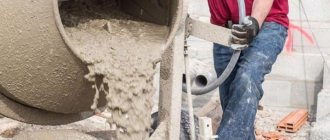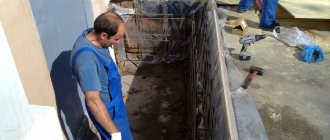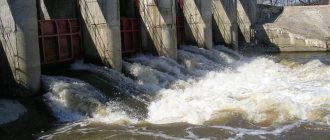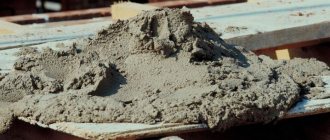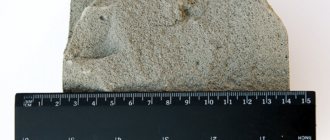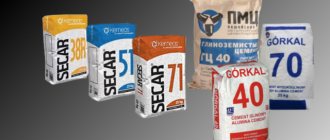Today, the use of cement is quite widespread - despite the emergence of new building materials, concrete based on a cement binder is still considered the most popular, universal and preferred option in many cases. Cement is a powdery substance that belongs to the inorganic class.
Cement is produced by grinding clinker, which, in turn, is obtained by firing clay and lime taken in certain proportions at high temperatures. Various minerals, plasticizers can be added to the powder to improve properties, etc. Cement is used as a binder when mixing concrete solutions of various types and purposes.
The main function of cement is high-quality fastening of structural elements of created structures and buildings being erected. Concrete mortars are used for pouring floors and various structural elements, monolithic construction, production of certain products, etc.
How any type of cement works:
- When mixed with water it turns into a viscous paste.
- The color changes from light gray to dark.
- Concrete quickly gains hardness in a humid and warm air environment.
The mixture gains strength within 28 days (usually) and gradually turns into an artificial stone with very high strength and durability characteristics. The properties of cement can be different and depend on a lot of factors: the type of binder itself, the presence of additives, features and conditions of use, compliance with mixing and laying technology.
Key indicators that are taken into account when choosing cement:
- Strength - indicated by the brand and the letter M (the higher the number next to it, the higher the strength: for example, M400 indicates that the stone can withstand a load of 400 kg/cm2). It is also calculated in classes (the letter B and next to it a two-digit number that displays the load that the material can withstand, in MPa).
- Frost resistance is an important characteristic, calculated in the number of freezing/thawing cycles.
- Corrosion resistance – the ability to withstand the negative influences of the environment. The most durable pozzolanic cement, it is used for the construction of underground/underwater objects.
- Water resistance - the ability to set in water and also withstand exposure to water and moisture if necessary.
- Sulfate resistance is the ability to withstand exposure to water with sulfate ions, which is important when constructing hydraulic structures that come into contact with salt water.
- Grinding fineness affects the hardening period and strength. The finer the powder is ground, the stronger the concrete will be.
Additional properties can be provided by special additives in the powder, the volume of which is always indicated by the manufacturer on the packaging in the labeling and description.
Cement production
All types of cement are produced using the same technology. The components and their proportions may differ, some minerals and other substances may be added at the end, but the production itself always involves certain stages and actions. All modern mixtures are based on Portland cement.
Simplified description of cement production technology:
- Obtaining primary raw materials: ground limestone and clay are mixed into slurry in a 4:1 ratio.
- In the process of burning sludge at a temperature of +1500 degrees Celsius, the raw materials are sintered into a solid mass called clinker.
- The clinker is ground very finely to a powder state.
Mineral additives and gypsum are added to the clinker powder to obtain cement with the desired properties.
Compound
Cement contains several components at the molecular level. The material is a thin gray powder, but the components in its chemical formula are different and are responsible for certain processes in concrete.
What substances does cement contain:
- Calcium oxide – in a volume of about 67%.
- Silicon oxide – in volume up to 22%.
- Aluminum oxides – up to 5%.
- Iron oxide – in a volume of up to 3%.
- Various types of modifying components – maximum 3%.
Materials that form the basis of cement:
- Clinker made of clay and lime - the strength and other properties of the material depend on its quality.
- Mineral components are special additives to improve characteristics and expand the scope of use of cement. These can be crushed shale materials, granulated slags, pozzolanic ingredients, lime, etc.
- Auxiliary components with calcium sulfate - to regulate the characteristics of the hydration process.
- Special additives are synthetic components that increase resistance to acids, temperatures, aggressive environments, and alkalis.
Portland cement differs in composition not only due to the addition of components to it during the production process, but also due to the characteristics of the places where raw materials are extracted. So, in each region the cement is different, although the differences are insignificant.
Material composition options:
- Various types of clay (including shale and loess).
- Marl, limestone, chalk, other carbonate rocks.
- Mineral additives: silicas, aluminas, apatite, fluorite, fluorspar, gypsum, phosphogypsum, etc.
Strength
Strength is one of the most important properties of cement, which determines the scope of application, expected loads, and technical characteristics of a concrete monolith structure. Cement acquires standard compressive strength after 28 days from the moment of mixing.
Strength can be viewed by brand (the most popular cement brands are M300, M400 and M500, indicating strength in kg/cm2) and class (the indicated brands correspond to approximate indicators B20, B30 and B40). The prepared solution begins to harden within 1-2 hours, the process is completed at least 12 hours after installation.
Next, hydration heat appears and the concrete gains strength within 28 days. At low external temperatures, heat allows cement to gain a full cycle of strength; at high temperatures, it can provoke an acceleration of the reaction, as a result of which cracks propagate due to the appearance of temperature stresses.
The strength of cement is looked at on the packaging and in special tables; for each sphere and type of structure, a certain load, the optimal indicator is sought. Strength is also affected by compliance with the technology of mixing the solution, laying it, and aftercare.
Properties of cements
Normal density
.
Unlike other building materials, cement is tested in a hydrated state in the form of dough or sand mortar. Therefore, the test results are influenced not only by the physical and chemical characteristics of the binder, but also by the content and characteristics of all materials used during testing: water, sand, special additives. In addition, the methods of preparing cement paste or mortar and the conditions under which hardening processes take place are of great importance. Great attention must be paid to selecting the amount of water for mixing cement. When tested according to GOST, the normal density of cement is determined by measuring the immersion depth of a standard pestle. The normal density of cement paste characterizes the amount of mixing water in % of the mass of cement and is approximately 22-28% for Portland cement. It depends on the chemical and mineralogical composition of the clinker, the specific surface area of the cement, the content of tripoli or blast furnace slag additives allowed by GOST up to 20%, and some other factors. The setting time and the uniformity of volume changes are determined using cement paste of normal thickness. Setting speed
.
Portland cement, mixed with the amount of water established when determining its normal density, forms a mobile plastic dough, which, depending on the chemical and mineralogical characteristics of the clinker, the specific surface area and the material composition of the cement, gradually loses its mobility over several hours, turning into a dense body. During mixing of the dough, the contacts that have arisen between the hydrate formations of the colloidal fractions of cement are broken, and the dough remains mobile despite the gradual increase in cohesion. The longer hydration lasts, the more hydration new formations become and the higher the density of the structure. The time during which a continuously compacting and coagulating structure is formed is the period of setting, i.e., the formation of the structure. Thus, the setting of cement should be considered as the initial stage of the overall hardening process. According to GOST, the beginning of setting should occur no earlier than 45 minutes and end no later than 12 hours from the moment of mixing. Normal setting times for Portland cement are achieved by grinding clinker together with the addition of a selected amount of gypsum, at which the S03 content in the cement should be no less than 1.5% and no more than 3.5%. With a larger addition of gypsum, setting can be accelerated. The setting of cement is slowed down due to the fact that thin films of calcium hydrosulfoaluminate gel are deposited on the surface of cement grains, quickly formed as a result of the interaction of calcium sulfate with tricalcium aluminate. These gel films inhibit the diffusion of water to the cement grain, which reduces the rate of hydration. Due to the extremely high dispersion of the resulting calcium hydrosulfoaluminate gel, it is difficult to detect under a microscope. Retarders can also be hemihydrous gypsum and anhydrous calcium sulfate (anhydrite); the effectiveness of their action is associated with different degrees of solubility. When using natural anhydrite, the formation of calcium hydrosulfoaluminate in already completely hardened cement due to the delayed (slow) solubility of anhydrite can lead to the occurrence of very dangerous stresses in the cement stone, since the volume of crystallizing calcium hydrosulfoaluminate increases. If there is an excess gypsum content, it is also possible for dangerous stresses to appear in well-hardened cement due to the ongoing reaction of formation of calcium hydrosulfoaluminate. When choosing a gypsum additive, the specific surface area and grain composition of the cement are of great importance, and relatively more additive should be added to cements with a high alkali content. For medium- and high-aluminate cements, a slightly larger addition of gypsum causes an increase in strength in the first days of hardening and a decrease in shrinkage and expansion. It is characteristic that the addition of gypsum can even accelerate the setting of low-aluminate cements rich in calcium aluminoferrites, and in this case there is no tendency to increase the initial strength and to reduce volumetric changes. The optimal addition of gypsum for each cement can be established only on the basis of data from experimental grinding of cements in factory grinding units with their characteristic aspiration system, temperatures of the cement being ground, its granulometric composition, etc. False setting. Sometimes the so-called false setting of cement occurs, characterized by the fact that the cement paste sets prematurely with a large release of heat. However, with further mixing, the dough liquefies and sets normally. This phenomenon is explained by the fact that when grinding hot clinker, especially in open-cycle mills, the temperature of the cement sometimes rises to 150°C and higher. This causes dehydration of the gypsum with the formation of not only hemihydrate, but also completely dehydrated calcium sulfate - anhydrite in soluble form. Rapid hydration of anhydrite and semi-hydrous gypsum is accompanied by premature thickening of the cement paste, which liquefies with further mixing. False setting of cement can cause a rapid loss of plasticity of the concrete mixture during mixing or transportation to the point of use. It can be prevented by deep cooling of the clinker, grinding it, mainly in separator mills, or by cooling the body of open-cycle mills, strong aspiration, and also by feeding a sprayed air-water mixture into the last chamber of the mill. Testing cement for false setting consists of modifying the standard definition of the normal thickness of cement paste and repeating the test at short intervals - 3-5 minutes with intermediate mixing. The rate of false setting of a concrete mixture is affected by temperature, mixing conditions and time, type of aggregate, etc. It is possible to localize the phenomena of false setting of cement by introducing a small addition of SDB, gypsum or mineral oil. However, not all cements experience false setting even at high grinding temperatures. It is believed that it may be caused by the presence of a large amount of free lime or underburning in the clinker charge being ground. When mixing cement with a high specific surface area, compacted lumps are often formed, which disintegrate with further mixing. It has been noted that their rapid setting is caused by the transition of alkalis into carbonates as a result of interaction with carbon dioxide during long-term storage of cement in air. In some cases it has the character of a false apprehension. There is data on other types of retarders (except gypsum), their effect in most cases depends on the dosage. Carbonates, chlorides and nitrates can be considered to be set accelerators; sulfates and phosphates are retarders, with the exception of alumina sulfate, which acts as an accelerator. There is different information about the effect of non-ferrous metal additives. They were considered set retarders, but recent work has shown the positive effect of adding small amounts of zinc on the hardening of Portland cement. B. E. Yudovich and N. T. Vlasova note that high-quality alite cements that do not contain additives other than gypsum can be characterized by aeration-induced false setting. It is caused by the formation of ettringite in thin layers of condensate on the dislocation network of the surface of cement particles. Water holding capacity
.
When mixing cement with water, both in laboratory and industrial conditions, you can see how some cements completely retain water during the setting period, while others separate a small layer of varying thickness. Since the water-cement ratio when preparing a concrete mixture usually always exceeds the value established when determining the normal density of cement paste, water separation becomes especially noticeable. The homogeneity of concrete and the adhesion strength of the cement mortar in it with coarse aggregate and steel reinforcement largely depend on it. When laying concrete layer by layer, the water released from it accumulates on the surface of the layers being laid. As a result, a contact layer of concrete with a high water content is formed, which causes delamination of the concrete, violating its solidity, and this is especially undesirable when laying massive concrete. Delamination can also occur inside concrete; the film of water formed as a result of water separation can significantly reduce the adhesion of the cement mortar to coarse aggregate and reinforcement. The evaporation of this water causes the formation of an additional number of pores, facilitating the diffusion of aggressive water into the depths of the concrete. An increase in water-holding capacity is achieved by introducing an active mineral additive into the original cement (in the form of tripoli, opoka), as well as the use of certain surfactants. The dosage and type of additive must be previously determined experimentally. Water separation can be useful, for example, when vacuuming or using water-absorbing formwork, when single-layer concreting small structures, when making reinforced concrete pipes using the centrifugation method, and in other cases when it is necessary to reduce the W/C and increase the density and strength of concrete. Uniformity of volume change is an important property of cement, which is determined in accordance with the requirements of the standard. At a certain humidity, cement stone shrinks or expands slightly. However, changes in the volume of the stone are very small and do not noticeably affect the uniformity of volume changes during standard testing. The expansion of the cement stone, which causes curvature of the samples under study or the appearance of hairline cracks on them, is the result of a delayed, but very strong in its effect, hydration of chemically unbound free calcium oxide in the clinker. This expansion is called apparent, since the volume of slaked lime is less than the sum of the volumes of the original calcium oxide and water that entered into the reaction. It is believed that the particles of the resulting slaked lime grow predominantly in one direction; this creates stresses that cause expansion of the mass, which theoretically amounts to 95.5% of the volume of the original calcium oxide. This phenomenon occurs during the hydration of coarse calcium oxide crystals, which requires prolonged interaction with water. Cement stone also expands with an excessive content of coarse-crystalline grains of peri-clase (magnesium oxide), as well as with a large amount of gypsum additive. Factories produce clinker with the minimum permissible amount of free calcium oxide in cement, the content of periclase and gypsum in which ensures uniform volume changes. This is achieved through fine grinding of the raw material mixture of uniform composition, high-quality firing and rapid cooling of the clinker. Since the expansion of cement stone can manifest itself to dangerous proportions many years after the cement has been mixed, the standard provides for an accelerated method of testing cement. According to GOST, standardly produced cakes of cement paste are subjected to boiling in water one day after mixing; after cooling, they should not have any bending or even hairline cracks. In a number of countries, the test is carried out according to the Le Chatelier method by boiling, one day after mixing, a cylinder of cement paste, cut to length and equipped with two needles, the ends of which diverge under the action of stresses resulting from the expansion of the cement stone. The permissible expansion is 3-10 mm, and its maximum size is provided for in most standards. A number of countries regulate the autoclave method for testing prism samples for 3 hours at a pressure of 2.1 MPa. In the USA, the expansion of Portland cement is allowed at 0.8%, in other countries - 0.5, 1 and even 1.3%. Heat dissipation.
Hydration of cement is accompanied by the release of heat, which can be determined by the change in temperature of the cement paste placed immediately after mixing in a thermos.
In thin-walled concrete structures, this heat dissipates relatively quickly and does not noticeably affect the structure of the cement stone. The problem of heat generation has attracted the attention of researchers due to the fact that in massive concrete of hydraulic engineering and other types of structures the temperature increases noticeably to a value that often exceeds, by approximately 323 K, the temperature of the concrete during its laying. Rising temperatures cause stresses, which are the result of uneven heating and cooling of the concrete; when its thermal conductivity is low, the internal layers of the massif cool more slowly than the surface layers. When large thermal stresses occur in concrete, cracks may appear. To eliminate these phenomena, thin concrete mixtures are used, if possible, or pipes are laid in the thickness of the massif, through which water flows to cool the concrete. Clinker minerals, when fully hydrated, differ in their thermochemical effect, which for C2S consists of the heat released both during the chemical reaction and during the adsorption of water by the gel and amounts to 504 kJ/kg. The heat release during hydration of C3S is 260 kJ/kg. The heat of hydration for C4AF is 420 kJ/kg and for C3A - 869 kJ/kg. The heat of formation of calcium hydrosulfoaluminates is 558 kJ/kg anhydrous C3A. The heat of hydration for CaO is determined to be 1170 kJ/kg and for MgO - 852 kJ/kg. The study of heat release during hydration of Portland cement of various mineralogical composition confirmed that the most thermal minerals in cement are C3S and C3A, and C4AF slows down the heat release of other minerals. The main amount of heat is released in the first 3-7 days of hardening. The approximate heat release of pure, additive-free Portland cement for different curing times can be determined using coefficients developed in our country that characterize the share of participation of clinker minerals in this process. The introduction of small amounts of active mineral additives into Portland cement does not significantly affect the established dependence. The standard thermochemical characteristics of cement are determined according to GOST using the thermos method. The test is carried out on a cement mortar in which the ratio between cement and sand is set depending on the type and brand of cement so that the maximum temperature increase is close to 288K. The consumption of cement per unit volume of solution increases if pozzo-lane and slag Portland cement are used instead of Portland cement. With an increase in cement consumption per 1 m3 of concrete, heat generation increases almost linearly. An increase in W/C leads to a noticeable increase in the thermal effect in the case of using alite and aluminate cements. The dependence of heat release on W/C for concretes made with belite cement is less. For concretes with the same cement consumption and mobility, the isothermal heat release does not depend on the properties of the aggregates, specific heat capacity and average density of the grain material. Plasticizing and air-entraining additives have different effects on heat release. The introduction of hardening accelerators leads to an increase in heat generation. Swelling and shrinkage of cement. Swelling and shrinkage are caused by the ability of cement stone and concrete to change volume depending on the chemical processes occurring during hardening and on the humidity of the environment in which they are located. Swelling is accompanied by the absorption of water and an increase in the mass of cement stone, reaching 3-5% with a hardening duration of 100 days. Concrete in water swells less than cement stone; in 6-12 months. volumetric changes stabilize, although the mass continues to increase. Swelling does not cause a decrease in strength, as happens with “delayed” hydration of CaOs, periclase, or during the interaction of cement alkalis with a reactive concrete filler. The swelling of cement stone should be considered as a result of interaction with water, in which the resulting cement gel adsorbs water on its extremely developed surface, pushing apart the hydrated new formations. Therefore, when swelling, the internal structure of the cement stone becomes denser. There is no doubt that swelling is also caused by the wedging effect of thin films of water and osmotic forces arising due to the difference in concentrations of hydrated particles on the surfaces, and the semi-permeability inherent in cement stone. Cement stone and hardened concrete in an air-dry environment shrink, accompanied by loss of water. The rate of shrinkage increases with decreasing relative humidity of the environment, and the absolute value of shrinkage (mm/m) is several times higher than swelling. Shrinkage is also observed when calcium hydroxide in cement stone interacts with carbon dioxide in the air. This reaction proceeds most fully with a certain relative humidity. The shrinkage of concrete can lead to significant stresses, the formation of microcracks and macrophines, a violation of the monolithic structures and thereby create conditions for the active action of other external aggressive factors. The shrinkage is also undesirable in pre -tense structures. When calculating the losses of preliminary voltage, as well as in the calculations of statically indefinable systems, the standard values of shrinkage deformations are taken so far only depending on the concrete brand for compression without taking into account the type of Portland cement used, as well as on the rigidity or mobility of the concrete mixture. The strength of the cement is one of its most important physical and mechanical characteristics, on which the strength of concrete in various hardening conditions mainly depends. The cement is determined by the strength indicators of cement by experiencing hardened samples from the sand mortar in the set firm life. During these tests, we already deal with the product of chemical interaction with water, which occurs during hydration of cement, therefore, the conditions under which these chemical processes occur on the obtained strength indicators of cement mortar. The standards for cement testing methods strictly regulate a water -cement ratio, conditions for the preparation, sealing and hardening of test samples, their tests, the composition of the solution, the type of sand used, samples. The standard methods of each country have their own distinctive features, so it is impossible to accurately compare the strength indicators of cements obtained in different countries. Such a comparison is possible only if, according to various standard methods, the same sample of cement is tested. Alita and alit Portland cement is characterized by the proximity of the coefficients of strength of strength (from 1 month to 2 years). When comparing the intensity of hardening and cements with a predominance of these minerals, a certain difference is observed, especially noticeable to Belita and Belitic Portland Counser during hardening from one month to six. This is explained by the fact that the noticeable increase in the strength of Belita during this period cannot manifest itself during the hardening of cement, since the processes associated with the participation of C3S hardening are crucial for the formation of the strength of cement stone. In special Portland cements, slag, pozzolan, plasticized, hydrophobic, etc., the influence of the mineralogical composition of the initial cement clinker on cement strength is preserved, however, with lower relative values of the resulting strength indicators. At the same time, it is necessary to take into account the possibility of changing these coefficients depending on the composition of concrete, the content in the composition of the cement of active mineral additives, the conditions for its manufacture and temperature and humidity conditions of hardening. The rate of interaction of cement grains with water depends on the total surface of the grains or their specific surface (cm2/g). With an increase in the subtlety of grinding (specific surface), the rate of hardening processes increases and the strength of cement stone increases. In order to obtain a given strength, it is necessary to choose not only the mineralogical composition of the initial clinker and the material composition of the cement, but also the optimal granulometry of cement powder with a certain specific surface. With an increase in the specific surface, regardless of its mineralogical composition, more cement is hydrated. To prevent significant development of shrinkage and other undesirable phenomena, the dosage of gypsum should be correctly selected. Not only strength depends on the cement, but also other properties of concrete, first of all, such as frost resistance, crack resistance, etc. The requirements for the specific surface of the cement should be put forward taking into account these properties. With the rational granulometric composition of cement, conditions are created for the prolonged flow of cement hardening processes that ensure its “self -ensuring” in various tense conditions. It is possible to significantly accelerate the hardening of cement and increase its strength up to 28 days by introducing special supplements - hardening accelerators, which are mainly the salts of one -to -line, two -clad and trivalent metals. The greatest practical use was received by calcium chloride, as well as the additives of sulfate and sodium and potassium carbonates. The optimal dosage of additives is usually installed experimentally. The creep of cement stone and its ability to relax stresses when it dries increases. Devis's observations for the creep of concrete, which lasted for 30 years, showed that the deformation of creep after 1 year, adopted per unit, increases two years later to 1.14, after 5 years - up to 1.2, after 10 years - up to 1, up to 1, up to 1, up to 1 26, after 20 years - up to 1.33 and after 30 years - up to 1.36. Despite a large number of studies of a single equation to describe the laws of deformations of the creep of concrete in time. Linear and nonlinear creep deformations have been identified. To a certain border of the load when compressing the deformation of creep, it is linearly depend on the voltage value in concrete. The transition of linear creep into nonlinear occurs in the material in conditions of compression at a voltage above RT, when microcracks are detected. An analysis of physical phenomena in concrete shows that the long -term action of the load with the voltages exceeding RT causes the destruction of the structure captured by changing the speed of ultrasound. The creep measure is of different importance for concrete on ordinary Portland cement and on high -strength. For calculations, it is accepted that creep on a high -strength Portland cement is less. They proceed from the fact that a decrease in creep measure with an increase in the age of concrete is the same for ordinary and high -strength Portlandnes. Frost resistance
is the ability of concrete to resist alternating freezing and thawing when saturating it with fresh or sea water. The “free” water located in the voids and macropors of cement stone freezes in the most quickly in water saturated water; This occurs at a temperature slightly below zero, since the water contains such soluble hydrate neoplasms as alkalis, etc. The temperature of freezing of water in the capillarpax depends on the size of the capillaries; In especially small ones, it is formed at minus 233-223k. With a further decrease in temperature, the amount of water that turns into ice increases, but even at 195k, some of the water in the smallest pores inside the gel remains. As you know, the transformation of water into ice is accompanied by an increase in volume by 9%. G. I. Gorchakov believes that the main factors that determine the stress in the walls of the capillaries of cement stone when the water freezes are: the degree of filling the capillaries with water, the permeability of the walls in relation to water, the rate of crystallization of water and parameters characterizing the internal size of the capillaries and the thickness of their walls . Reducing the strength and destruction of concrete under the influence of alternating freezing and thawing is explained mainly by stresses that occur in the structure of cement stone and concrete. It is also believed that the destruction of the walls of the pores in cement stone during freezing and thawing is a consequence of the occurrence of hydraulic water pressure in front of the freezing front. To get concrete of increased frost resistance, it is very important to choose the right cement, taking into account its chemical-mineralogical composition, dispersion, the presence of active mineral additives, as well as air-attractive, gaseous, plasticizing and hydrophobic substances. Cement consumption per 1 m3 of concrete, the type and quality of the used aggregates are also important. The most frost -resistant concrete of the alitic high -strength, as well as on sulfate -resistant Portland cements. The least frost -resistant at freezing temperatures to minus 223k concrete on pocoColan and slag port -cements due to a high amount of water, adsorptionly withheld in these cements with active mineral additives. It should be noted that praing reduces the frost resistance of cement concrete.
Types of cement
When considering cement, the types are indicated in a fairly large number, but they do not exhaust the variety of materials that can be created from the binder. Indeed, with the right approach, it is possible to impart different properties to cement by introducing certain additives into the composition. And due to the fact that cement is used in a wide variety of fields and areas, there are many options for preparing the mixture. The composition of the powder can also vary due to the characteristics of the raw materials mined in a particular region.
Consideration of the most popular types of cement:
- Portland cement is a universal base material that is used in a wide variety of repair and construction work in almost all areas.
- Aluminous - produced on the basis of limestone or alumina, relevant for urgent emergency work, in winter, when exposed to mineralized water, as it sets quickly. Not suitable for use in hot climates.
- Magnesium - made on the basis of magnesium oxide, sealed with magnesium chlorides and sulfates. Cement is moisture-resistant and durable and is used in various fields.
- Lime-slag - it contains 30% lime and 5% gypsum.
- Finely ground - Portland cement with sand and mineral additives (limestone, perlite, ash, slag, volcanic materials).
- Phosphate - it contains oxides, phosphoric acid and other compounds that produce phosphate hardening in compounds.
- Mixed - the main substance is silicon oxide, additives are added to the composition (slag, fired clay, ash and fuel substances, expanded clay, gypsum, sedimentary rocks, etc.).
- Acid-resistant - soluble glass, acid-resistant fillers for hardening, and an aqueous solution of sodium silicate are added to the mixture.
- Special oil well cement - for its production, gypsum, clinker and triethanolamine are crushed together.
- Colored - white Portland cement is mixed with pigments or natural dyes (ochre, red lead, chromium oxide) are added at the stage of clinker firing with further grinding.
- Waterproof - the main ingredients are bauxite, limestone, aluminum oxide.
- Masonry cement includes 20% Portland cement clinker, as well as blast furnace slag and various mineral materials.
- Slag-alkali - produced from waste and slag of blast furnaces, which with alkalis create a durable and high-quality hardening building material.
- Sulfate-resistant - an ordinary composition with modifying additives that make the binder resistant to negative effects and more durable.
- Expanding is cement that increases in volume during hardening in air due to the introduction of certain hydraulic additives into the composition.
- Carbonate - it is made on the basis of siderite or clayey carbonate rocks with 25-30% dolomite or limestone.
- Hydrophobic - a composition with special additives that make it resistant to water.
- Pozzolanic cement is the collective name for a category of materials that contain at least 20% active mineral additives.
In addition, you can find many other compounds on the market that can be used when performing certain types of work in certain conditions and areas.
Property of Portland cement
Strength is the ability of materials to withstand loads without collapsing. Strength is determined by its ability to harden after mixing with water.
This is a hydraulic binder, the main component of which is calcium silicate. It is most common in modern construction. It is obtained by finely grinding clinker and gypsum (3-7%); It is allowed to add 10-15% active mineral additives. Clinker is the result of firing (1450-1500 degrees) a raw material mixture, which consists of 75% calcium carbonate (limestone) and 25% clay. The properties of Portland cement are influenced by the composition of the clinker and the degree of its grinding. An important property is the ability to harden when interacting with water. It is characterized by a grade, which is determined by the compression and bending resistance of a standard sample of mortar after 28 days of hardening under wet conditions.
The most important property is the ability to harden when interacting with water and acquire a stone-like state. The greater the mechanical strength of hardened stone mortar or concrete and the faster it is achieved, the better the quality.
Therefore they differ:
- The ultimate strength that a solution can acquire when curing.
- Hardening rate, which is characterized by the intensity of strength growth over time.
Cement that is characterized by a high increase in strength is called quick-hardening, and when high strength is still achieved, it is called high-strength.
Mechanical strength is determined in different ways, for example, by assessing tensile, compressive, and bending strength. In this case, the selection of the composition of mixtures, storage, production and testing of samples are carried out in accordance with the requirements established by the relevant standards.
Sulfate resistant
Sulfate-resistant Portland cement has a low hardening rate and frost resistance.
In addition to the usual, they produce varieties that differ in properties, composition and scope of application: sulfate-resistant, hydrophobic, plasticized, quick-hardening, white Portland cement (for the production of asbestos-cement products), etc.
Sulfate-resistant is a type of Portland cement. It has high resistance to the effects of mineralized waters that contain sulfates, low heat generation, slow hardening intensity and high frost resistance. Sulfate-resistant is obtained by finely grinding clinker with a standardized mineralogical composition. It is intended for the production of reinforced concrete and concrete structures of hydraulic structures that are exposed to the aggressive effects of a sulfate environment (for example, sea water), mainly in conditions with variable moisture (freezing and thawing).
The starting raw material is clay with a low content of alumina and iron. This mixture should not contain any inert or active mineral additives. Such raw materials are not widely used, and this hinders the widespread production of sulfate-resistant Portland cement.
Slag is crushed granulated blast furnace slag with an admixture of activating additives.
Slag is a combined name for cements obtained by grinding granulated blast furnace slag with the addition of activators (lime, building gypsum, anhydrite) or mixing these separately crushed components. There is a distinction between lime-slag cement, containing 10-30% lime and 5% gypsum by weight, and sulfate-slag cement, containing 15-20% anhydrite or gypsum, and 5% Portland cement or 2% lime. Slag is used to produce mortar and concrete, which are used in underwater and underground structures. The most effective is lime-slag in the production of autoclave products.
Pozzolanic is the name for a group containing at least 20% mineral active additives. Compared to ordinary Portland cement, it is characterized by increased corrosion resistance, lower hardening speed and reduced frost resistance. It is used for the production of concrete used in underground and underwater structures.
Aluminous
Features include waterproofness, frost resistance and fire resistance.
Aluminous – hydraulic, fast-hardening binder; obtained by grinding clinker, which is obtained by firing a raw mixture of limestone and bauxite. Melting and firing of the raw material mixture is carried out in cupola furnaces or blast furnaces.
The Al2O3 content in the final product determines the type of alumina cement: high-alumina (up to 70%) and regular (up to 55%). It is distinguished by increased resistance to corrosion, rapidly increasing strength, high exotherm during hardening and high fire resistance. With the help of aluminous cement, concrete and mortars of greater water resistance and density are obtained than with Portland cement.
Hydrophobic Portland cement is obtained by grinding clinker with a water-repellent additive and gypsum. The additive is introduced in an amount of 0.1-0.3% and forms thin hydrophobic films on the particles, which reduce hygroscopicity and protect it from spoilage even under high humidity conditions. Mortars and concrete have low water absorption, greater frost resistance and water resistance, unlike conventional mortars.
Tensile cement is characterized by rapid setting, water resistance, frost resistance and crack resistance.
Backfilling is a type of Portland cement; which is intended for cementing gas and oil wells. It is made by jointly finely grinding gypsum and clinker and used in the form of dough with a water content of 40-50%.
Tensing is a type of expanding. It is obtained by grinding 15% aluminous slag, 65% Portland cement clinker and 5% lime. It hardens quickly and sets quickly.
Once cured, it is highly waterproof. Expanding during hardening, it reaches high pressure, which is used to create reinforced concrete structures with reinforcement tension in several directions. Tensing is used in the production of pressure pipes, for the construction of capacitive structures and thin-walled structures made of reinforced concrete.
Main brands
Cement grades are designated by the letter M and numbers from 25 to 1000. The most common grades are M100, M200, M300, M400 and M500. The rest are used for specific tasks and much less frequently. The most versatile and durable cement grades are M400 and M500. As mentioned above, the numbers next to the index indicate the load in kg/cm2 that the hardened stone can withstand.
Grades below M100 and M200 are used for plastering, masonry, above M600 - for the construction of special-purpose objects (military, bunkers, missile silos, etc.).
In addition to strength, cement markings can provide many other important information. First of all, pay attention to the letters.
What do the letters in the cement marking mean:
- PC – Portland cement.
- SPC – slag-Portland cement.
- B – quick-hardening composition.
- SS is a binder with sulfate-resistant properties.
- PL is cement already containing a plasticizer.
- N – standardized, cement with confirmed strength.
- WRC – waterproof cement (used in the construction of hydraulic structures).
Also, according to GOST 31108, the presence of additives in the powder is indicated: I means that there are no additives; II – cement contains mineral components. The volume of additives is indicated by letters: A – 6-20% of mineral components, B – 21-35%. Additives can be pozzolan, slag, polymers, etc. The hardening speed is also indicated by letters: N - normally hardening binder, C - average speed, B - quick-hardening mixtures.
Additives in cement are also indexed by the letter D and numbers indicating the percentage of content. D0 - no additives, D20 - 20% additives are included in the cement, as a result of which the substance is more plastic. The general rule is: the higher the grade, the greater the strength; the higher the percentage of additives, the more elastic the cement (but at critical levels, the strength may decrease).
The most popular brands of cement:
- M100, M200, M300 – production of various elements and products with the required characteristics.
- M400 – used when pouring prefabricated/monolithic reinforced concrete.
- M500 - relevant for the production of hydraulic structures and slabs that are in water of varying levels, for pouring curbs and sidewalks, foundations of all types.
- M600 – concreting of prefabricated structures of improved quality.
- M700 – work with buildings where high loads and stress zones are noted.
Classification
With the introduction into circulation of the regulatory document “GOCT 31108-2003. General construction cements. Technical specifications" existing designations of cement brand and grade were unified with the countries of the European Union.
There are five main types. In accordance with current standards, cement is classified using symbols:
- Portland cement CEM I is usually called “pure” because it does not contain impurities. This type of cement is most widely used in the construction of industrial and civil facilities, for the production of prestressed concrete, precast reinforced concrete and mortars for monolithic works. One of the varieties - white Portland cement, containing bleaching additives - is used for the preparation of dry construction mixtures.
- Portland cement with mineral additives CEM II - contains alumina, bauxite, limestone and various alloying impurities. The main advantage of this type of cement is the relatively rapid increase in strength, so after 24 hours of hardening it reaches 80 - 90% of the standardized value. Used on construction sites to quickly complete concreting work. The solutions obtained from it can be used at temperatures down to -10 degrees Celsius, without the use of additional protection. Grade CEM II is not recommended to be mixed with other types of cement.
- Portland slag cement CEM III is produced by grinding, at the final stage of preparation, cement clinker with granulated blast furnace slag. Calcium sulfate is added as a supplement. Slag cement is similar in appearance to ordinary cement, but has well-defined distinctive properties. It is particularly suitable for environments exposed to low aggressive water. It requires special care during hardening, so the screed must be sprayed generously with water for two weeks, not allowing it to dry out. If this condition is not met, the concrete will not gain sufficient strength. It is used in industry, in particular, in the manufacture of monolithic structures for various hydraulic structures operating in conditions of high risk of corrosion.
- Pozzolanic cement CEM IV is a mixture produced from cement clinker, fly ash (waste from coal combustion in power plants) and gypsum. The properties of this type of cement are similar to those of Portland slag cement, but are characterized by low heat generation during hydration and increased resistance to aggressive water. It is used both in general and in specialized construction, as well as for the production of cellular concrete.
- Composite cement CEM V or multicomponent. It can hardly be called Portland cement, since the content of additives exceeds 35% and can reach up to 80%. Depending on the composition of the additives, it can have different properties, therefore it has strictly specialized applications.
These types (from CEM II to CEM V), in turn, are divided into three types: A, B, C - according to the percentage of impurities and additives in relation to the main component - clinker.
An additional symbol in the marking contains a subclass designation, where the letter N corresponds to a normally hardening composition, and the letter B to a rapid-hardening composition, respectively.
Additional information: According to the European standard EN 197-1, the marking of cement is designated: CEM I, CEM II, CEM III, CEM IV and CEM V and is deciphered in complete analogy with our GOST.
Application area
The scope of application of cement directly depends on its properties and characteristics. SNiPs and GOSTs indicate all the rules and features of the use of different grades of cement with certain technical characteristics in the construction of buildings, production of products, etc. The choice of cement is also influenced by the conditions of its use, assigned tasks, and operating features.
Where is cement used:
- Carrying out general construction work - from the construction of outbuildings and low-rise buildings to the pouring of multi-storey buildings, in prefabricated and monolithic foundations and ceilings, pouring floors and walls. Cement is also used for mixing masonry and plaster mortar.
- Road industrial construction – construction of runways, bridges, hydraulic structures, load-bearing parts of multi-storey buildings.
- Extractive industry – strengthening of technical structures, plugging of gas/oil wells.
- Structures operated in difficult and aggressive conditions - with high sulfates, in acids, where frequent freezing/thawing occurs.
Some useful tips for using cement
In order for a concrete solution made from cement to meet all requirements and be suitable for creating strong, reliable, durable structures and products, it is necessary to remember some rules.
Useful recommendations for the use of cement:
- The binder should be stored for no more than 3 months and only in a place protected from moisture and wind. It is best on special pallets, in factory bags.
- The correct recipe should be found immediately and components can only be added at the stage of mixing the dry ingredients. When the cement is mixed with water, it is no longer possible to add dry components. Therefore, water is initially poured a little at a time, achieving the desired consistency.
- An open bag of cement can be stored for no more than 1 week in low humidity conditions and a maximum of 1 day in high humidity conditions.
- Crumpled cement cannot be used - some advise breaking up the stones and using it as a regular binder, but the reaction has already passed and the chemical formula cannot be returned. Such cement can be used only in the form of a filler, and then in a volume not exceeding a third of the total volume of fillers.
- When mixing concrete, you must strictly follow the proportions; any deviation will reduce the properties.
- In cold weather, you need to use special frost-resistant cement. In extreme heat, it is better not to work or to organize careful care of the hardening concrete.
- More cement or too high a grade does not mean higher strength. You should always focus on standards and use the brand that is suitable for a specific type of work. If you choose a low-grade binder, concrete will not provide the required characteristics; if you choose a high-grade binder, the costs will not be justified due to its irrelevant properties.
